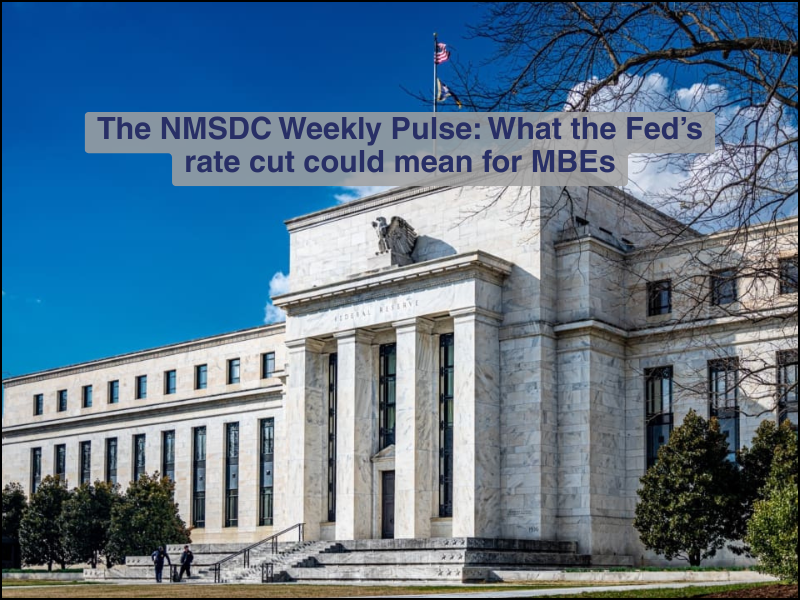On September 17, 2025, the Federal Reserve lowered its
benchmark interest rate by 25 basis points (0.25 percentage points) to
a new target range of 4.00%–4.25%. This was the Fed’s first rate
cut since December, and Chair Jerome Powell described it as a “risk-management”
move – intended to counter softening in the labor market and other economic
headwinds, even as inflation remains above the 2% target.
This policy shift has important implications for businesses
of all sizes, but particularly for minority business enterprises (MBEs),
which often operate with thinner margins, smaller balance sheets, and higher
financing costs. Let’s unpack what this rate cut could mean for Black,
Hispanic, Asian, Indigenous, and other minority-owned businesses — both the
opportunities and the challenges.
Why MBEs Are More Sensitive to Interest Rates
While rate cuts affect all businesses, MBEs are often
disproportionately impacted because of structural financing barriers:
- Higher
borrowing costs. Research shows Black-owned businesses pay on
average 3.09 percentage points more in interest than
comparable white-owned businesses. Hispanic-owned firms pay 2.91
percentage points more and Asian-owned firms 2.88
percentage points more.
- Smaller
scale. Roughly 97% of Black-owned employer firms have
fewer than 20 employees, limiting their collateral and financial history.
- Credit
gaps. Many MBEs are under-banked or denied loans outright,
leaving them more reliant on costly alternative financing.
Because of these challenges, even a modest 25-basis-point
cut can matter – though whether MBEs can capture the benefits depends heavily
on access to affordable credit.
The Upside: Relief, Opportunity, Potential
- Lower
cost of borrowing.
The most direct benefit to MBEs is cheaper credit. Loans, lines of credit, and other financing should gradually become less expensive. For MBEs already paying higher-than-market rates, this translates into reduced debt service payments and more room to reinvest in operations, staff, or technology. - Greater
capacity for investment and expansion.
Lower financing costs improve growth projects: equipment upgrades, technology adoption, new hires, or expansion into new markets. For MBEs that are younger and often on a growth trajectory, this creates room to scale more aggressively. - Stronger
cash flow management.
For firms that rely heavily on short-term borrowing or revolving credit lines to cover payroll and inventory, even small declines in borrowing costs can ease monthly burdens and reduce stress on working capital. - Spillover
benefits from a stronger labor market.
The Fed’s decision was partly about supporting jobs in the face of rising unemployment. Stronger consumer demand – particularly in minority and younger communities where job losses have been most pronounced – can help drive revenues for MBEs rooted in those communities.
The Downside: Why Rate Cuts Alone Aren’t Enough
- The
gap remains wide.
Even with lower benchmark rates, MBEs still face spreads of two to three percentage points above what white-owned firms pay. A quarter-point cut helps, but structural inequities blunt much of the impact
- Access
is uneven.
The firms most in need of cheaper credit are often the least likely to receive it. If an MBE can’t get a loan at all, lower rates are meaningless.
- Pass-through
isn’t automatic.
Banks and non-bank lenders may delay lowering their lending rates, or they may offset cuts with new fees or tighter lending standards.
- Inflation
risk lingers.
With inflation still above target, the Fed could reverse course if price pressures mount. That creates planning uncertainty for MBEs making long-term financing decisions.
Some Practical Steps for MBEs
- Review
existing debt. Explore refinancing or restructuring loans to take
advantage of lower rates.
- Engage
lenders proactively. Strong banking relationships and up-to-date
documentation (financial statements, tax returns) improve your ability to
access better terms.
- Balance
fixed and variable debt. Evaluate whether locking in rates now
helps reduce exposure to future policy reversals.
- Consider
CDFIs and mission-driven lenders. Community lenders may pass
through rate cuts faster and provide technical assistance to MBEs.
What Partners and Corporate Members Can Do
Corporations, financial institutions, and anchor firms can play a crucial role in ensuring MBEs share in the benefits of easier monetary policy by:
- Expanding
supplier credit programs to include working capital support tied
to rate cuts.
- Partnering
with CDFIs and minority lenders to increase the flow of
affordable credit.
- Offering
loan guarantees or credit enhancements to reduce perceived risk
for lenders and narrow spreads for MBEs.
- Providing
technical assistance to help MBEs package their financing
applications and strengthen their credit profiles.
Bottom Line
The Fed’s September 17th cut is a modest but important step.
For MBEs, the opportunity lies not just in lower borrowing costs, but in how
quickly and fairly those benefits reach minority entrepreneurs. Closing the gap
between policy and practice requires intentional action – by
lenders, corporations, and partners across the NMSDC network.
If we seize this moment, we can help MBEs weather current
headwinds, invest in growth, and continue fueling inclusive economic
prosperity. Join NMSDC in Miami, November 2-5, at the NMSDC
Annual Conference and Exchange where these and other important
discussions will take place!





